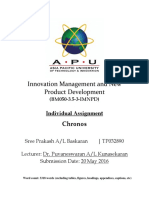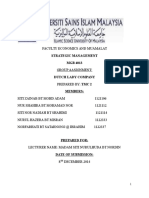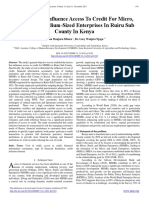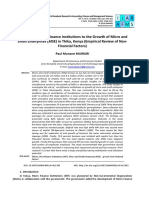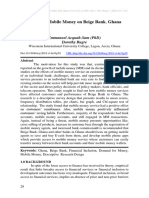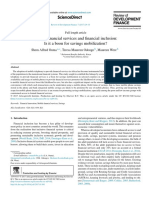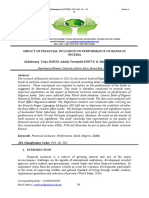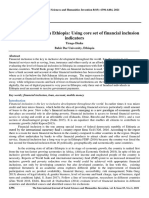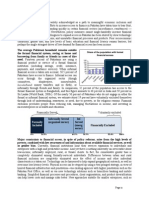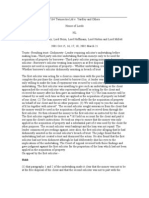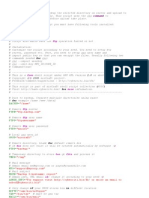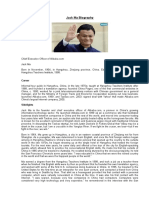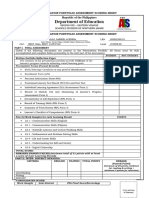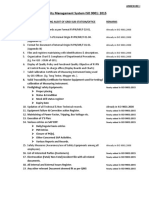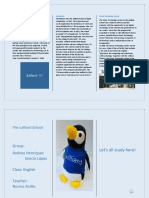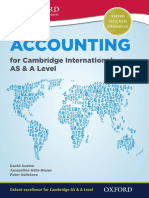Professional Documents
Culture Documents
Financial Innovations and Financial Inclusion Among Small Scale Coffee Farmers in Kiambu County, Kenya
Original Title
Copyright
Available Formats
Share this document
Did you find this document useful?
Is this content inappropriate?
Report this DocumentCopyright:
Available Formats
Financial Innovations and Financial Inclusion Among Small Scale Coffee Farmers in Kiambu County, Kenya
Copyright:
Available Formats
Volume 8, Issue 5, May 2023 International Journal of Innovative Science and Research Technology
ISSN No:-2456-2165
Financial Innovations and Financial Inclusion
among Small Scale Coffee Farmers in
Kiambu County, Kenya
Sadik Abdi Adan & Dr. Gordon Opuodho
Jomo Kenyatta University of Agriculture and Technology
P.O Box 62000-00200 Nairobi, Kenya
Abstract:- Despite the strong presence of various million people are ranked in the lowest category of earning.
financial technologies in remote areas, most inhabitants Apart from socioeconomic and demographic features, the
in these areas remain financially excluded. In Kenya, main drivers of enhancing inclusion were; an operative
majority of the small-scale farmers are the aged people governing framework and policy setting and promoting the
and presumed to be slow in adoption of technology. For actions of financial service providers.
this reason, financially it is not clear to what extent
financial innovations have improved financial inclusion Triki and Faye (2013), describes financial inclusion as
among the farmers. The objective of the study was to the process through which formal financial services are
establish the innovations within mobile banking on how made available, accessible and at a lower cost which all can
they influence financial inclusion among small scale afford. Financial inclusion penetration rate is high in
coffee farmers in Kenya with a scope of Kiambu County developed nations, which is not the case in middle level and
coffee farmers. The study was informed by financial developing countries. A report by the World Bank (2017),
intermediation theory and technology acceptance theory indicate that 19% of adults in developed countries face a
descriptive research design was adopted as it is suitable mild financial inclusion deficiency whereas 72% of adults in
for providing a comprehensive examination of the developing nations do not have a bank account. An average
situation and give a report of diversified features from of various statistics reports shows that an average half of the
the analysis. The target population comprised of small- world‘s adult population is unbanked (Nyagilo, 2018).
scale coffee farmers situated in Kiambu County. This Additionally, access to traditional banking services, such as
study was targeting the top 10 coffee co-operatives automatic teller machines and over the counter services in
societies with a target population of 29,455. Using the bank branches differs significantly from one country to
Cochran formula, a sample size of 395 five was selected. another (Klein & Mayer, 2016). For example, in Ethiopia
Primary data was collected by use of questionnaires. The there is less than one bank branch per every 100,000 people
data collected was analyzed using descriptive statistics to while in Canada the number is 220 bank branches per
determine the mean and standard deviation. Pearson 100,000 people nation-wide (The World Bank Report,
correlation and regression was conducted to determine 2017). For countries that have large unbanked populations,
the relationship between the variables. The regression mobile technology can be used as an alternative means to
results showed that mobile banking have a statically extend the reach of financial services.
significant effect on financial inclusion among small scale
farmers. The study concluded that innovations in mobile Most of the African countries have a high percentage
banking are very important in enhancing the rate of of financially left out people, which reflects a high
financial inclusion in the country. Therefore the study deficiency of access and application of formal financial
recommends that various stakeholders including resources by the people. The World Bank Report (2017)
financial institutions to consider putting more point out that the low spread of banking services in African
countries similarly shows a high rate financial excluded. In
infrastructure and innovation in mobile banking to
ensure financial inclusion among small scale farmers in 2011, fifty four percent of the South African population had
Kenya. bank accounts at formal financial institutions within the
country, while the figures for Kenya, Nigeria, Egypt and the
Keywords:- Financial Innovations, Mobile Banking and Democratic Republic of the Congo (DRC) were slightly low
Financial Inclusion. showing a rate of 42 percent, 30 percent, 10 percent and 4
percent respectively (World Bank, 2011). The level of
I. INTRODUCTION financial inclusion in African countries is generally very
low. In poorer rural communities, which comprise the bulk
Globally, 2.7 billion adults have a deficiency of of the financially excluded; Financial exclusion is mainly
modern financial services (Demirguc &Levine, 2009). The due to income-related issues and barriers to accessing formal
Financial Access Initiative (FAT) reported across the globe financial institutions (World Bank, 2011). In Sub-Saharan
2.5 billion people who lack access to financial services Africa, an estimated 47% of people live below US$ 1.25 in a
reside in developing nations in Africa, Asia, and Latin day. By being financially excluded, it implies that this
America. Based on the population breakdown by income population mostly relies on informal avenues to access
level, out of a population of 1.2 billion grown person using financial services which are so costly. This goes a long way
modern financial services, about 70%equivalent to 800
IJISRT23MAY1541 www.ijisrt.com 981
Volume 8, Issue 5, May 2023 International Journal of Innovative Science and Research Technology
ISSN No:-2456-2165
to adversely affecting the way formal financial institutions particularly from the year 2007. With the introduction of
perform (Ndegwa & Koori, 2019). mobile phone payment platform M-pesa, Airtel money Yu-
cash, which intensely changed the financial setting by
In Kenya, an estimated 46 percent of the residents offering a simple efficient and cost-effective ways to send
lives below the national poverty line (Kenya Bankers and receive money (Kenyoru, 2013). Other inventions such
Association, 2014) and traditionally, banking institutions as agency banking has enabled bank customers to access the
could not serve these low income individuals (the unbanked) fundamental banking services by authorizing small traders
because of the costs involved. This has resulted to adoption to operate as satellite branches (Musau, 2013). In 2012,
of innovations that can effectively help the low-income Safaricom Company in collaboration with Commercial Bank
individuals and micro entrepreneurs to develop hence of Africa in Kenya, launched a service dubbed M-SHWARI
financial inclusion. The key financial services that result that spontaneously opens a bank account for M-pesa
into financial inclusion among the unbanked and the under registered customer and operates fully like a bank account.
banked include pension and insurance services and products, This increased the population accessing the formal financial
loans, savings and payment services (Ndung’u, 2013). sector. Around 10 to 20 per cent of smallholder farmers in
Kenya is categorized as a lower middle income nation, Kenya are part of formal value chains, while the rest of the
according to a UNDP 2018 report. In this regard, 36.1 population operate using old tradition methods.
percent of her population lives below the international
poverty level of $1.90 per day, with the majority of them II. PROBLEM STATEMENT
residing in rural areas where formal banking services are
difficult to access (Omwansa & Waema, 2018). Farmers are key contributors to the growth of Kenyan
economy. They play a double role of production as well as
Innovations has been refers to as an organizations consumption. According to the annual AGRA report (2019)
coming up with new products or new production methods to about less than 4 per cent of business loaning is borrowed
enhance effectiveness and efficiency in their operations, in for the agriculture sector. Public expenditure on agriculture
which case the new products could be based on the new stands at 3 to 6 per cent of the budget. The Agricultural
methods adopted (Lawrence, 2010). In the financial markets, sector in Kenya comprise of majority small scale farmers
innovation has been presumed as the act of developing and with a few large scale farmers. While smallholder farmers
marketing new financial instruments, technologies, are significant in contributing to the growth the Kenyan
institutions and markets, which enable access to economy, financial amenities barely reach them. Lack of
information, trading and means financial transaction (Sum & capital, low returns have been attributed to the main
Memba, 2016). The principal purpose of innovation is to challenge hindering growth of small scale farmers in Kenya
reduce operating cost, increase equality and improved (KNBS economic survey report, 2022). Smallholders
services (Mukur, 2014). On the other hand, administrative farmers are not well reached by either informal or formal
process innovation involves the indtroduction of a new financial sector due to some of the remote location or
organization method in the business practices with an aim to perceived level of risk and economic value by the service
increase firm performance by reducing operating expenses providers.
and improving workplace satisfaction (Damanpour, 2011).
According to COSA report (2019) on coffee
Financial innovation refers to the action or a process of production in Kenya, Smallholder farming controls Kenya’s
inventing and implementation of new financial instruments coffee sector, producing about 65 per cent of the total
and technologies, markets and institutions (Jofi, 2015). metrics exported. However, there has been a decline in
Financial Innovation involves the design, development and quality of coffee produced due to poor management in the
implementation of advanced financial products and farms. Lack of finances due to delayed payments, difficult in
processes, which are a creative solutions to problems in access of credit and harsh weather condition have
finance. Ignazio (2007) categorize financial innovations contributed to the decline in production and quality.
into; new products; new services; new "production" Additionally, the farmers also experience lack of research
processes for example electronic record keeping and new capacity to develop new resistant high producing varieties.
organizational forms. According to the year 2017 Global Findex catalogue, 81.6%
of the 29.6 million Kenyans aged from 15 years and abovein
Financial inclusion refers to growing access to formal the urban have an account with a financial institution or
financial which involve various parameters such as mobile money provider. In rural areas, this figure is slightly
possession of bank accounts, using credit and savings lower at 81.2 %. Financial inclusion in Kenya has grown as
facilitated through financial institutions. Across the decades a result of high rates of mobile money adoption and use.
financial inclusion has increased further than physical 72.9% of the residents aged 15 years and above in urban
branch as technology is transforming the access and use of area a mobile money account. In the rural the figures are
bank services worldwide (Diniz et al, 2012). Financial equally high at 72.6 per cent. Fin Access survey (2021)
inclusion in Kenya just like it’s happening in other nations, asserts that the use of traditional forms to get financial
has been occasioned by prompt technological change in the services has decreased to 4.7 per cent in 2021 from 6.1 in
sector that hve led to the advancement of financial 2019. The implication was that there is an increasing
innovations, new products and new forms of transacting formality in the financial sector denoting a good
cash. According to the Central Bank of Kenya report (2012), implementation framework. Similarly, the access to informal
the banking sector has undergone a massive revolution financial services consumption were showing a declining
IJISRT23MAY1541 www.ijisrt.com 982
Volume 8, Issue 5, May 2023 International Journal of Innovative Science and Research Technology
ISSN No:-2456-2165
trend across the years. In particular, innovations in bank- (1983) examined the position of banks in transforming fixed
based products continue to offer competition to unregulated assets into liquid obligations. Accordingly, similar investors
digital lenders, hence the decline in usage of the later from and depositors are characterized by being risk averse; this
8.3 percent in 2019 to 2.1 percent in 2021. Despite the brings uncertainty in timing future opportunities. Through
strong presence of various financial technologies in rural intermediation, banks assist investors to avoid being locked
areas, most farmers remain financially excluded (Fin Access into long-term illiquid investments yielding high pay - offs
survey, 2021). to future consumers.
Several studies have been conducted to on the area of Commercial banks as financial intermediaries play a
financial innovation and financial inclusion globally and key role in ensuring good corporate governance, less risk
also in the region. Most of the studies conducted on contracts and ease of transaction for players in an economy.
financial innovation have focused on performance of By increasing the level of financial inclusion, banks attempt
financial institutions study therefore seeks to bridge the to reduce these market frictions. In turn, this reduces
existing gap by investigating the effects of financial information asymmetry hence reducing market
innovations on financial inclusion of small-scale coffee imperfections among the users (Hannig & Jansen, 2010).
farmers in Kiambu. This theory captures financial inclusion which is explained
by financial intermediation. The underpinnings of this
III. GENERAL OBJECTIVE theory can be used to help understand how financial
intermediation interrelates to financial inclusion. The theory
The general objective of the study seeks to explore the supports the Mobile banking objective considering it
effect of financial innovation on financial inclusion among operates as intermediary between the service provider and
small scale coffee farmers in Kiambu. the customers.
A. Specific Objectives Technology Acceptance Model (TAM)
To establish the effect of innovations in mobile banking The TAM motel was proposed by Davies in 1989, this
on financial inclusion among small scale coffee famers in model was developed anticipate the adoption of information
Kiambu. technology in an organization as well as user acceptance of
B. Research Hypotheses it. The goal of the Technology Acceptance Model is to use
H0: Innovations in Mobile banking have no significant specific services or technology to explain attitudes (Bertrand
influence on financial inclusion of small-scale coffee famers & Bouchard, 2018). TAM addresses fourteen believes in
in Kiambu. regard to new technology and contends that incase of
advancement of new technology to customers, is either due
IV. LITERATURE REVIEW to, perceived ease to operate and perceived usefulness
influence their decision (Lule, Omwansa & Waema, 2012).
A. Theoretical Framework Perceived ease to operate is the level of self-assurance that
The study adopted the financial intermediation theory, operators put on a system and if consumers perceive a new
technology acceptance theory to give an empirical technology to be helpful in support of both the current and
discussion of the innovations of mobile banking adoption. future, there is that motivation to accept and use the system.
Further, the level by which and individual consider a system
Financial Intermediation Theory will enhancement performance the short and long-run in the
The financial intermediation (FIT) theory was proposed perceived usefulness (Mojtahed et al, 2011).
by Diamond (1984). The theory is all about how banks act
as intermediaries between borrowers and savers. As Evrn though financial technology has advanced,
financial intermediaries they facilitate access to financial elemtns such as adequacy, accessibility, affordability and
services and also provide financial diversification and awareness are still lacking in some small scale farmers,
utilization. The degree of inclusion influences the level of preventing them from being completely financially engaged.
firmness as long-established by literature. According to This is a genial theory that supports the objectives of the
Ndebbio (2004), financial intermediation theory explains the study as to have a knowhow of how new technology and
role of commercial banks in bridging the gap between innovations influence financial inclusion among the farmers
deficit spending customers and surplus spending customers due to their reluctant to accept and adopt the new
in the market. technologies.
Diamond (1984) points out that commercial banks play B. Conceptual framework
the role of delegated monitoring by putting effective The independent variable for this study was innovations
measures necessary to monitor borrowers‟ behavior. By in mobile banking whereas the dependent variable was
reducing monitoring costs, banks are able to attain financial inclusion as represented in figure 1 below.
competitive edge in the market. Diamond and Dybvig
IJISRT23MAY1541 www.ijisrt.com 983
Volume 8, Issue 5, May 2023 International Journal of Innovative Science and Research Technology
ISSN No:-2456-2165
Innovations in Mobile banking
Farmer Credits products (Credit Financial inclusion
Inputs,Credit Voucher, Asset financing:
DigiFarm,MkopaFuliza& Hustler fund) Availability, access, and
Mobile wallet; payments and savings and usage of quality financial
services. services/products.
Farmer micro insurance: Acre Africa,
MKopa, FtMA
Independent variable Dependent variable
Fig. 1: Conceptual framework
C. Empirical Literature In Kenya, Antoine and Leo (2017) conducted a
Mobile banking refers to any financial related research on mobile money and financial inclusion. The
transactions relating the transfer or exchange ofmoney, study conducted was for the period between 2011 and 2013.
which is initiated and/or completed by using mobile with the The research main objective was to gather information about
aid of computer- mediated networks and an electronic financial behaviour at the family level. Families were picked
device (Kathuo et al, 2015). The authors further assert that randomly based on the latest available census. According to
mobile banking involves provision of bank-related financial the findings, the majority of poor and uneducated people do
services with the aid of mobile telecommunication gadgets. not benefit from this banking system since they are unable to
Mobile banking mostly transact through confirmation of get frequent and speedier remittances. According to another
short message service (SMS) or mobile internet but can also study conducted by Joseph (2018), in Kitui County, Kenya,
be used by special applications called clients downloaded to Mobile money technology significantly impacts financial
the mobile device (Gemechu, 2014). inclusion in the country. The study applied systematic
research design approach. The target population included of
Mobile banking has enhanced provision of financial 7060 individual residents positioned in urban centers in
services with a multiple applications of services that address Kitui County. The target population comprised of Mpesa
the need at hand (Daniyan-Bagudu et al, 2016).Mobile agents, petrol stations, supermarkets and mobile banking
banking offers to majority of customers a possibleway out in agents. Stratified sampling technique was applied to select a
developing markets that have access to a cell phone, yet sample of 351 respondent. The research used a researcher
remain excluded from the financial mainstream (Too et al, administered questionnaire to collect data. The study
2016). Mobile money transfers has provided basic financial concluded that policymakers should consider mobile
services more available by reducing time and distance to the technologies when formulating policies. The impact of
nearest physical bank branches (CGAP, 2006). The mobile banking could be greater if more customers use these
innovation has also helped minimize the bank‘s own fix services and if technology evolves.
costs and other operating expenses. Mobile banking offers
an opportunity for financial service provides to extend V. RESEARCH METHODOLOGY
banking services to new customers thereby increasing their
market (Ritho & Jagongo, 2015). Descriptive research design was applied for this study
with an interview method. The sign involves collecting
Mago and Chitokwindo (2014) conducted an inquiry information by administering questionnaires or through
on the influence of cellular banking on monetary inclusion interviews to a sample of respondents. The design was
in Masvingo Province, Zimbabwe. The investigators suitable for this studyconsidering that it is more precise and
assumed a qualitative approach in their survey design. The accurate as it involves explanation of events in a systematic
representative proportion of the population was made up of manner way (Babbie, 2004). This research design was also
270 participants from districts, informal sector and tertiary portray the characteristics of a population fully (Chandran,
learners. The outcomes of the research exposed that the poor 2004). Target population of interest in this study comprised
people were keen to embrace cellular banking and that there of small scale coffee farmers in Kiambu County. There are
is an affirmative relationship amid cellular banking and 23 coffee co-operatives societies in Kiambu with a total of
monetary inclusion. The work was done in Zimbabwe, 52,234 members registered as at December 2020 (Kiambu
rendering scarcity in terms of context and this is the gap that County government resource data). This study targeted the
the current study sets out to address. top 10 coffee co-operatives societies with a target population
of 29,455. The sample frame of this study consisted of
IJISRT23MAY1541 www.ijisrt.com 984
Volume 8, Issue 5, May 2023 International Journal of Innovative Science and Research Technology
ISSN No:-2456-2165
random selected farmers from the coffee cooperative test to test the validity and reliability of the questionnaires in
societies. The researcher used Cochran, (1963) formula to gathering the data required for purposes of the study.
determine the sample size of 395 small scale farmers in
Kiambu County. Data collected was sorted out to ensure completeness
and consistency. The data was then analysed using
𝑁 descriptive statistics on various measures of central
𝑛= tendency. The descriptive statistical tool (SPSS) was used to
[1 + 𝑁(𝑒)2 ]
aid the researcher to describe the data. The findings were
Where; n = sample size; N = Target Population size; e presented using tables and graphs for further analysis and to
=Level of significance, at 95% confidence level facilitate comparison. The quantitative reports were
presented through tabulations and measure of central
29,455 tendency.
𝑛= = 395
[1 + 29,455(0.05)2 ]
The researcher further employed multivariate
The study used questionnaires as the data collection regression model to study the relationship between financial
tool where relevant information related to the study innovations and financial inclusion among small scale
objective was gathered. The questionnaire was structured in farmers in Kiambu.
such a way that it contained both close ended questions and
open ended questions. 395 questionnaires were administered The regression model is as follows:
to the selected coffee farmers. The questionnaire was Y = β0 + β1X1 +ε Where:
administered inform of interview to guide the responded on Y = Financial inclusion
how to answer the questions provided. Interview was also β0 = Constant Term
providing room for interpretation to farmers who may not be β1 = Beta coefficients
in a position to read and write. The study carried out a pilot X1 = Mobile banking
ε = Error term
VI. FINDINGS AND RESULTS DISCUSSION
A. Descriptive statistics
Table 1: Reliability test
Variables Number Of Items Cronbach's Alpha
Financial inclusion 5 0.987
Mobile banking 10 0.935
Table 1 presents the results on reliability test. The Alphas for the two items tested were 0.987 and 0.935
finding revealed that reliability and internal consistency of respectively. The results were all above the required cut-off
the items constituting; Financial inclusion, Mobile banking minimum value of 0.7; therefore, all the items in the
constructs were established. The individual Cronbach’s questionnaire were reliable.
B. Response Rate
Table 2: Response Rate
Response Rate Number Percentage
Responded 360 91
Non response 35 09
Total 395 100
Table 2 specifies that out of the 395 questionnaires that response rate was 91 %, which was high and adequate for
were administered, 360 were duly filled and picked from the further analysis.
respondents. 35 were not respondent to. The overall
C. Mobile Banking
Table 3: Mobile banking
Mobile banking Mean Std. Deviation
I make deposits through the mobile phone for every daily sale. 3.27 1.074
I withdraw money through mobile phone for petty cash use In case of shortages 3.36 1.111
Am aware of Fuliza service, and it helps in emergency times. 3.38 1.093
Am aware of hustlers fund service, and it helps in emergency times. 3.22 1.020
I am aware of farmers digi farm application 3.15 1.127
I am able to transact using farmers digi farm application 3.24 1.170
I am aware of mobile wallet 3.17 1.173
IJISRT23MAY1541 www.ijisrt.com 985
Volume 8, Issue 5, May 2023 International Journal of Innovative Science and Research Technology
ISSN No:-2456-2165
I have made some transaction via mobile wallet 3.06 1.074
I use M-Pesa to pay my employees and suppliers 2.97 1.233
I have heard about Farmer micro insurance: Acre Africa, MKopa, FtMA 2.93 1.116
The study aimed to find out the respondent’s opinion farmers digi farm application 3.1556, I am able to transact
on various measures of Mobile banking. Table 3, presents using farmers digi farm application 3.2444, I am aware of
the analyzed results which show that on a scale of 1 to 5 mobile wallet 3.1778, I have made some transaction via
(where 1= strongly disagree; 2 = disagree; 3= moderate and mobile wallet 3.0667, I use M-Pesa to pay my employees
5 = strongly agree). The means were; I make deposits and suppliers 2.9778, I have heard about Farmer micro
through the mobile phone for every daily sale 3.27, I insurance: Acre Africa, MKopa, FtMA 2.9333. the mean
withdraw money through mobile phone for petty cash use In implies that majority of the respondents were to the same
case of shortages 3.36, Am aware of Fuliza service, and it opinion regarding the various construct of innovations in
helps in emergency times 3.38, Am aware of hustlers fund mobile banking.
service, and it helps in emergency times 3.22, I am aware of
D. Financial inclusion
Table 4: Financial inclusion
Financial inclusion Mean Std. Deviation
Various financial innovations have made ease access to financial services 3.33 1.087
The available financial technology services enable payment ability. 3.51 1.121
The available financial technology services have increased credit accessibility ability 3.42 1.076
That the cost and charges of transacting though financial innovations is affordable 3.42 1.076
That there is an increase in production of coffee since the development of financial technology. 3.40 1.053
The study sought to examine the respondent’s level of technology services have increased credit accessibility
agreement or disagreement on the various measures of ability 3.42, That the cost and charges of transacting though
financial inclusion. Table 4, presents the relevant results financial innovations is affordable 3.42, That there is an
which show that on a scale of 1 to 5 (where 1= strongly increase in production of coffee since the development of
disagree and strongly agree=5).The means were; Various financial technology 3.40. The results show an element of
financial innovations have made ease access to financial normal distribution as the mean variance in the various
services 3.33, The available financial technology services statement was minimal.
enable payment ability 3.51, The available financial
E. Regression Analysis
Table 5: Model Summary
R R Square Adjusted R Square Std. Error of the Estimate
0.922 0.850 0.849 0.40608
Table 5, presents the Fitting Statistics results for the interpretation was that all the variables are statistically
study variables from the results it was observed that the significant. Thus they were relevant and were retained for
explanatory power of the study variables was R Square regression level.
0.850 and Adjusted R-Square 0.849 respectively. The
Table 6: Analysis of variance
Model Sum of Squares df Mean Square F p-value
1 Regression 333.500 3 111.167 674.127 0.000
Residual 58.706 356 0.165
Total 392.206 359
Table 6, presents the ANOVA results for the study are statistically significant since the associated p =value was
variables from the results it was observed that the ANOVA found to be 0.000.
value was 674.127. The interpretation was that the variables
Table 7: Regression Results
Variables Coefficient Std Error t-Statistic P-Value
(Constant) 0.356 0.082 4.347 0.000
Mobile Banking 0.616 0.042 14.821 0.000
IJISRT23MAY1541 www.ijisrt.com 986
Volume 8, Issue 5, May 2023 International Journal of Innovative Science and Research Technology
ISSN No:-2456-2165
Y = 0.356 + 0.616 X1 + ε C. Recommendations
The mobile banking variable was revealed to be an
Where: important determinant of financial inclusion among small
scale coffee farmers. Financial institutions such as
Y = Financial inclusion, X1 = Mobile banking and ε = commercial banks, micro finance banks and SACCOs
Error term should therefore come up with strategies to ensure that then
From table 7, the regression coefficient of mobile usage of mobile banking is encouraged the small scale
banking was found to be 0.616. This value shows that coffee farmers to participate in the financial inclusion
holding other variables in the model constant, an increase in initiatives. Since the findings showed Mobile Banking
mobile banking by one unit causes the financial inclusion enhanced the financial inclusion among small scale coffee
among small scale coffee farmers to increase by 0.616 units. farmers, the central bank, county and national governments
The value of the coefficient is also positive. The positive should hatch plans to enhance the usage of mobile banking
effect shows that there is a positive relationship between by making sure that there are adequate infrastructure to do
mobile banking and financial inclusion. The associated p = so. The key stakeholders should do something to enhance
value was 0.000 for the 14.821 t-statistic which show the usage of Mobile Banking to ensure inclusive access to
statistically significance of the mobile banking variable. The banking services in the country.
variable was thus found to be the most influential variable REFERENCES
on financial inclusion among small scale coffee farmers in
Kiambu county, Kenya. [1.] Ahmad, S. Z., & Muhammad Arif, A. M. (2015).
Strengthening access to finance for women owned
VII. SUMMARY, CONCLUSIONS AND SMEs in developing countries. Equality, Diversity
RECOMMENDATIONS and Inclusion: An International Journal, 34(7),
A. Summary of Findings 634-639.
The specific objective of the study was to establish the [2.] Central Bank of Kenya (CBK) (2012). The 2016
effect of innovations in mobile banking on financial FinAccess Household Survey on financial
inclusion among small scale coffee famers in Kiambu. All inclusion. Nairobi, Kenya: FSD Kenya.
the constructs of Mobile Banking were found to influence [3.] Cooper, D. R., & Schindler, P. S. (2008). Business
financial inclusion among small scale coffee farmers since Research Methods (10th Ed.). New York: McGraw-
their descriptive values had values greater than the middle / Hill.
mean value of 5/2 = 2.5 on the Likert scale. The regression [4.] Davies, F. (1989). Perceived Usefulness, Perceived
coefficient for the association between innovations in Ease of Use, and User Acceptance of Information
mobile banking and financial inclusion among small scale Technology. MIS Quarterly, Vol. 13(3), 319-340.
coffee famers in Kiambu was found to be significant [5.] Demirguc-Kunt, A., & Levine, R. (2008). Finance,
(p<0.05) and positive. Therefore the study rejects null financial sector policies, and long run growth. The
hypothesis; H01. Innovations in Mobile banking have no World Bank.
significant influence on financial inclusion of small-scale [6.] Diamond, W. (1984). Financial Intermediation and
coffee famers in Kiambu. The study finding shows that Delegated Monitoring, Review of Economic Studies,
innovations in mobile banking have greatly lead to financial Vol. 51(3), 393-414
inclusion among the scaled farmers sampled. [7.] Diamond, W., & Dybvig, H. (1983). Bank Runs,
Deposit Insurance, and Liquidity, The Journal of
B. Conclusions Political Economy. Vol. 91(3), 401-419.
The study concluded that Mobile Banking has influence [8.] Diniz, D, Rene, B & Marlei, P, (2011). Triggers and
on financial inclusion among small scale coffee farmers. Barriers to Financial Inclusion. The use of ICT-Based
The study found that the farmers were aware of; making Branchless Banking in an Amanon country,
deposits through the mobile phone for every daily sale, Electronic Commerce Research and Application,
withdrawing money through mobile phone for petty cash use Vol.11 (2012) 484-494
In case of shortages, usage of Fuliza service helps in [9.] FINACCESS HOUSEHOLD SURVEY (2021).
emergency times, use of hustlers fund service, helps in Financial Inclusion Information and Insights to
emergency times, awareness of farmers digi farm Support Evidence-Based Decisions.
application, ability to transact using farmers digi farm [10.] FinAccess. (2016). The 2016 FinAccess household
application, awareness to mobile wallet, usage of M-Pesa to survey. Article, 306(February), 36.
pay my employees and suppliers and Farmer micro [11.] GSMA Annual report (2019) Improving-financial-
insurance such as Acre Africa, MKopa, FtMA. This study inclusion-through-data-for smallholder farmers-in-
also concluded that mobile banking was an influential Kenya.
variable. [12.] Ignazio, V. (2007). Financial Deepening and
Monetary Policy Transmission Mechanism, BIS
Review 124/2007.
[13.] International Coffee Organization (ICO), (2013).
Website www:http//ico.org, April, 2016, Accessed
April, 2016.
IJISRT23MAY1541 www.ijisrt.com 987
Volume 8, Issue 5, May 2023 International Journal of Innovative Science and Research Technology
ISSN No:-2456-2165
[14.] Kathuo, S., Rotich, G., & Anyango, A. (2015). Effect
of mobile banking on the financial performance of
banking institutions in Kenya. The strategic journal
of business and change management, 2(98), 1440-
1457.
[15.] Kithinji, E. (2017). Effects of digital banking strategy
on financial Inclusion among commercial banks in
Kenya. Unpublished Masters Project, University of
Nairobi, Kenya.
[16.] Kleijnen, M., de Ruyter, K., Wetzels, M. (2013). An
assessment of value creation in mobile
service delivery and the moderating role of time
consciousness, Journal of Retailing, 83 (1) 33-46.
[17.] Kothari, C. (2004). Research Methodology: Methods
& Techniques, 2nd edition. New age International
Publishers, New Delhi, India
[18.] Lawrence, J.W. (2010). Technological Change
Financial innovation and Financial Regulation in the
US, the Challenges for Public policy, cited from
citeseerx.ist.psu.edu/viewdoc/download?doi=10.1.1
.155.1655.
[19.] Lule, I., Omwansa, T. K. & Waema, T. M. (2012).
Application of Technology Acceptance Model
(TAM) in M-Banking Adoption in Kenya.
International Journal of Computing and
ICTResearch, 6(1), 31-43.
[20.] Mojtahed, R., Nunes, J.M.B. & Peng, G.C. (2011).
The role of The Technology Acceptance Model
in Information Systems’ Research. In proceeding of
the International Workshop on Information Systems
Research Trends, Approaches and Methodologies
Rome, Italy.
[21.] Ndebbio, J. (2004), “Financial Deepening, Economic
Growth and Development: Evidence from Selected
sub- Saharan African Countries” African Economic
Research Consortium (AERC) Research Paper
Working Paper No. 142.
[22.] Ndung’u. M. (2013). Central Bank of Kenya.
Technical Cooperation among Developing Countries
Programme on “Mobile and agency banking in
Kenya”, Kenya School of Monetary Studies, Nairobi
Kenya.
[23.] Sum R., & Memba F. (2016). The effect of financial
innovation on the financial performance of deposit
taking SACCOs in Kenya, a case of Kiambu County.
International journal of social science and
technology 2(5), p.443.
IJISRT23MAY1541 www.ijisrt.com 988
You might also like
- LAW 3100 - Persons & Family Relations - JD 33. G.R. No. 221029 - Republic vs. Manalo - Case Digest 8Document5 pagesLAW 3100 - Persons & Family Relations - JD 33. G.R. No. 221029 - Republic vs. Manalo - Case Digest 8John Kenneth ContrerasNo ratings yet
- Harnessing Technology for More Inclusive and Sustainable Finance in Asia and the PacificFrom EverandHarnessing Technology for More Inclusive and Sustainable Finance in Asia and the PacificNo ratings yet
- Trade Like A Boss FINALDocument74 pagesTrade Like A Boss FINALGoran KristanNo ratings yet
- IMNPD AssignmentDocument49 pagesIMNPD AssignmentSreePrakash100% (3)
- Factors Affecting Property Value PDFDocument2 pagesFactors Affecting Property Value PDFJennifer100% (1)
- Dutch Lady NK Present Isnin 1 C PDFDocument43 pagesDutch Lady NK Present Isnin 1 C PDFAbdulaziz Farhan50% (2)
- Contribution of Financial Inclusion On The Economic Development of Nigeria 1999 - 2020Document14 pagesContribution of Financial Inclusion On The Economic Development of Nigeria 1999 - 2020Editor IJTSRDNo ratings yet
- Nigeria and Financial Inclusion - Way ForwardDocument10 pagesNigeria and Financial Inclusion - Way ForwardAyoNo ratings yet
- What Factors Influence Financial Inclusion Among Entrepreneurs in Nigeria?Document9 pagesWhat Factors Influence Financial Inclusion Among Entrepreneurs in Nigeria?International Journal of Innovative Science and Research TechnologyNo ratings yet
- Financial Inclusion in The Digital AgeDocument5 pagesFinancial Inclusion in The Digital AgeramNo ratings yet
- The Impact of Mobile Finance Use On Livelihoods of Farmers in Rural ChinaDocument14 pagesThe Impact of Mobile Finance Use On Livelihoods of Farmers in Rural ChinaLakshanaNo ratings yet
- I42-1020 ABPaper FINAL-DIGITALDocument25 pagesI42-1020 ABPaper FINAL-DIGITALRjendra LamsalNo ratings yet
- M-PESA and Financial Inclusion in Kenya of PayingDocument27 pagesM-PESA and Financial Inclusion in Kenya of PayingBabugi Ernesto Antonio ObraNo ratings yet
- The Micro Determinants of Financial Inclusion and Financial Resilience in AfricaDocument15 pagesThe Micro Determinants of Financial Inclusion and Financial Resilience in AfricakatrinkanjemNo ratings yet
- Chapter One Silas Project NewDocument10 pagesChapter One Silas Project NewSilas DanielNo ratings yet
- Chioma MSC Proposal 1-5 Updated-1Document104 pagesChioma MSC Proposal 1-5 Updated-1Chioma EghosaNo ratings yet
- Factors That Influence Access To Credit For Micro, Small, and Medium - Sized Enterprises in Ruiru Sub County in Kenya by Mburu, S.MDocument10 pagesFactors That Influence Access To Credit For Micro, Small, and Medium - Sized Enterprises in Ruiru Sub County in Kenya by Mburu, S.MMburu SNo ratings yet
- 1238 3595 1 PBDocument14 pages1238 3595 1 PBWao wamolaNo ratings yet
- Financial Inclusion of The Poor in Developing Okellocandiyabongomin2019Document21 pagesFinancial Inclusion of The Poor in Developing Okellocandiyabongomin2019Wondwossen JereneNo ratings yet
- Cracknell KenyaDocument75 pagesCracknell Kenya최두영No ratings yet
- E BankingDocument11 pagesE BankingErika R. MartinNo ratings yet
- Financial Inclusion in Burundi - The Determinants of Loan Taking Motivation in Semi Rural AreasDocument15 pagesFinancial Inclusion in Burundi - The Determinants of Loan Taking Motivation in Semi Rural AreasRjendra LamsalNo ratings yet
- Ijeoma BKF Fin InclDocument55 pagesIjeoma BKF Fin Inclmgbemena Vivian kamsiNo ratings yet
- Article 23 The Role of Micro-Finance Institutions PDFDocument14 pagesArticle 23 The Role of Micro-Finance Institutions PDFbioduny2kNo ratings yet
- Has Expansion of Mobile Phone and Internet Use Spurred Financial Inclusion in The SAARC Countries?Document18 pagesHas Expansion of Mobile Phone and Internet Use Spurred Financial Inclusion in The SAARC Countries?Miguel DiraneNo ratings yet
- CBN Publication On Financial Inclusion - Issues and Challenges 2014Document49 pagesCBN Publication On Financial Inclusion - Issues and Challenges 2014simiolateju100% (1)
- 2.Ijbgm-A Cointegration Analysis of The Relationship Between Money Supply and Financial Inclusion in Nigeria - 1981-2016 - RewrittenDocument14 pages2.Ijbgm-A Cointegration Analysis of The Relationship Between Money Supply and Financial Inclusion in Nigeria - 1981-2016 - Rewritteniaset123No ratings yet
- Micro Financing and Economic Development: A Sectorial Microcredit Study From NigeriaDocument17 pagesMicro Financing and Economic Development: A Sectorial Microcredit Study From Nigeriasanthi pushadapuNo ratings yet
- Financial Inclusion 4Document6 pagesFinancial Inclusion 445satishNo ratings yet
- Our Money, Our Rights:: The Evolution of Financial Services in AsiaDocument20 pagesOur Money, Our Rights:: The Evolution of Financial Services in AsiaKhushbu BhimaniNo ratings yet
- Developing Informal Financing Option ForDocument11 pagesDeveloping Informal Financing Option ForAyeni OreoluwaNo ratings yet
- Microfinance and Poverty Reduction: New Evidence From PakistanDocument11 pagesMicrofinance and Poverty Reduction: New Evidence From PakistanMisal e FatimaNo ratings yet
- 11475-Article Text-32922-1-10-20181129Document29 pages11475-Article Text-32922-1-10-20181129Natinael AbebeNo ratings yet
- 2632 10346 1 PB PDFDocument10 pages2632 10346 1 PB PDFRajyaLakshmiNo ratings yet
- Financial Inclusion 4Document6 pagesFinancial Inclusion 4simran simieNo ratings yet
- KesuhchiandcharlespaperDocument14 pagesKesuhchiandcharlespaperAnthony MuchiriNo ratings yet
- The Evolution of The Microfinance in India - An OverviewDocument2 pagesThe Evolution of The Microfinance in India - An OverviewAdri MitraNo ratings yet
- Mobile Financial Services and Financial Inclusion Is It A Boon For Savings MobilizationDocument7 pagesMobile Financial Services and Financial Inclusion Is It A Boon For Savings MobilizationzZl3Ul2NNINGZzNo ratings yet
- Financial Inclusion - It TechnologyDocument6 pagesFinancial Inclusion - It TechnologysinghnaikNo ratings yet
- M-Banking in KenyaagriDocument18 pagesM-Banking in Kenyaagrimanojmis2010No ratings yet
- Financial Inclusion Through Microfinance Vineeta Agrawal: Applied Sciences Department, KIIT College of EngineeringDocument8 pagesFinancial Inclusion Through Microfinance Vineeta Agrawal: Applied Sciences Department, KIIT College of EngineeringVineeta AgrawalNo ratings yet
- Challenges Facing Micro and Small Enterprises in Accessing Credit Facilities in Kangemi Harambee Market in Nairobi City County, KenyaDocument25 pagesChallenges Facing Micro and Small Enterprises in Accessing Credit Facilities in Kangemi Harambee Market in Nairobi City County, KenyaKruh Kwabena IsaacNo ratings yet
- Effect of Mobile Banking On Financial Inclusion Among Comercial Bank in KenyaDocument14 pagesEffect of Mobile Banking On Financial Inclusion Among Comercial Bank in KenyaAl FahmyNo ratings yet
- MICKYYDocument24 pagesMICKYYphilipos.mesfinNo ratings yet
- Login: Access and Impact Assessment of Micro Finance Banks On Rural Poor in Nigeria: A Case Study of Edo StateDocument36 pagesLogin: Access and Impact Assessment of Micro Finance Banks On Rural Poor in Nigeria: A Case Study of Edo Statetrantrongphong021185No ratings yet
- 2038 - Gjcra - Kanu Clementina Isu Gabriel 142207 PDFDocument20 pages2038 - Gjcra - Kanu Clementina Isu Gabriel 142207 PDFEdmund ZinNo ratings yet
- Abudo Dika Final Research 01Document50 pagesAbudo Dika Final Research 01Hussein IbrahimNo ratings yet
- M-Pesa Kenya vs. IndiaDocument4 pagesM-Pesa Kenya vs. IndiaSyed fayas thanveer SNo ratings yet
- Mellen ProposalDocument11 pagesMellen ProposalWomayi SamsonNo ratings yet
- The Effects of Financial Inclusion On Po PDFDocument11 pagesThe Effects of Financial Inclusion On Po PDFMotin OstagarNo ratings yet
- 1.2 Statement of The ProblemDocument19 pages1.2 Statement of The ProblemJohnson JohnNo ratings yet
- Impact of Financial Inclusion On Performance of Bank in NigeriaDocument14 pagesImpact of Financial Inclusion On Performance of Bank in NigeriaMiguel DiraneNo ratings yet
- Financial InclusionDocument90 pagesFinancial InclusionRohan Mehra0% (1)
- 6 - Factors That Influence Demand For Credit Among Small-1Document30 pages6 - Factors That Influence Demand For Credit Among Small-1iisteNo ratings yet
- Translate BBBDocument35 pagesTranslate BBBekiNo ratings yet
- Literature Review On Financial InclusionDocument17 pagesLiterature Review On Financial InclusionthenosweenNo ratings yet
- 12 - Analysis of Determinants Affecting Financial Inclusion in IndonesiaDocument8 pages12 - Analysis of Determinants Affecting Financial Inclusion in IndonesiaRjendra LamsalNo ratings yet
- Financial Inclusion - Economic Growth Nexus: Traditional Finance Versus Digital Finance in Sub-Saharan AfricaDocument31 pagesFinancial Inclusion - Economic Growth Nexus: Traditional Finance Versus Digital Finance in Sub-Saharan AfricaEsinam AdukpoNo ratings yet
- 2994 ArticleText 9188 1 10 20210331Document9 pages2994 ArticleText 9188 1 10 20210331OlloNo ratings yet
- Financial Inclusion Introduction andDocument32 pagesFinancial Inclusion Introduction andAstik TripathiNo ratings yet
- Executive Summary: Hawala/hundi Money Transfers, and So Forth), orDocument7 pagesExecutive Summary: Hawala/hundi Money Transfers, and So Forth), orSyed Uzair Hassan GillaniNo ratings yet
- Financial Literacy Amongst Informal Enterprise Owners in ZambiaDocument13 pagesFinancial Literacy Amongst Informal Enterprise Owners in ZambiaInternational Journal of Business Marketing and ManagementNo ratings yet
- 7.Man-Entrepreneurial Firms and Microfinance-OYEDOKUN Akintunde JonathanDocument10 pages7.Man-Entrepreneurial Firms and Microfinance-OYEDOKUN Akintunde JonathanImpact JournalsNo ratings yet
- Research Method End of Year Exam ProjectDocument12 pagesResearch Method End of Year Exam ProjectRaissa KoffiNo ratings yet
- Connecting the Disconnected: Coping Strategies of the Financially Excluded in BhutanFrom EverandConnecting the Disconnected: Coping Strategies of the Financially Excluded in BhutanNo ratings yet
- Cyber Security Awareness and Educational Outcomes of Grade 4 LearnersDocument33 pagesCyber Security Awareness and Educational Outcomes of Grade 4 LearnersInternational Journal of Innovative Science and Research TechnologyNo ratings yet
- Factors Influencing The Use of Improved Maize Seed and Participation in The Seed Demonstration Program by Smallholder Farmers in Kwali Area Council Abuja, NigeriaDocument6 pagesFactors Influencing The Use of Improved Maize Seed and Participation in The Seed Demonstration Program by Smallholder Farmers in Kwali Area Council Abuja, NigeriaInternational Journal of Innovative Science and Research TechnologyNo ratings yet
- Parastomal Hernia: A Case Report, Repaired by Modified Laparascopic Sugarbaker TechniqueDocument2 pagesParastomal Hernia: A Case Report, Repaired by Modified Laparascopic Sugarbaker TechniqueInternational Journal of Innovative Science and Research TechnologyNo ratings yet
- Smart Health Care SystemDocument8 pagesSmart Health Care SystemInternational Journal of Innovative Science and Research TechnologyNo ratings yet
- Blockchain Based Decentralized ApplicationDocument7 pagesBlockchain Based Decentralized ApplicationInternational Journal of Innovative Science and Research TechnologyNo ratings yet
- Unmasking Phishing Threats Through Cutting-Edge Machine LearningDocument8 pagesUnmasking Phishing Threats Through Cutting-Edge Machine LearningInternational Journal of Innovative Science and Research TechnologyNo ratings yet
- Study Assessing Viability of Installing 20kw Solar Power For The Electrical & Electronic Engineering Department Rufus Giwa Polytechnic OwoDocument6 pagesStudy Assessing Viability of Installing 20kw Solar Power For The Electrical & Electronic Engineering Department Rufus Giwa Polytechnic OwoInternational Journal of Innovative Science and Research TechnologyNo ratings yet
- An Industry That Capitalizes Off of Women's Insecurities?Document8 pagesAn Industry That Capitalizes Off of Women's Insecurities?International Journal of Innovative Science and Research TechnologyNo ratings yet
- Visual Water: An Integration of App and Web To Understand Chemical ElementsDocument5 pagesVisual Water: An Integration of App and Web To Understand Chemical ElementsInternational Journal of Innovative Science and Research TechnologyNo ratings yet
- Insights Into Nipah Virus: A Review of Epidemiology, Pathogenesis, and Therapeutic AdvancesDocument8 pagesInsights Into Nipah Virus: A Review of Epidemiology, Pathogenesis, and Therapeutic AdvancesInternational Journal of Innovative Science and Research TechnologyNo ratings yet
- Smart Cities: Boosting Economic Growth Through Innovation and EfficiencyDocument19 pagesSmart Cities: Boosting Economic Growth Through Innovation and EfficiencyInternational Journal of Innovative Science and Research TechnologyNo ratings yet
- Parkinson's Detection Using Voice Features and Spiral DrawingsDocument5 pagesParkinson's Detection Using Voice Features and Spiral DrawingsInternational Journal of Innovative Science and Research TechnologyNo ratings yet
- Impact of Silver Nanoparticles Infused in Blood in A Stenosed Artery Under The Effect of Magnetic Field Imp. of Silver Nano. Inf. in Blood in A Sten. Art. Under The Eff. of Mag. FieldDocument6 pagesImpact of Silver Nanoparticles Infused in Blood in A Stenosed Artery Under The Effect of Magnetic Field Imp. of Silver Nano. Inf. in Blood in A Sten. Art. Under The Eff. of Mag. FieldInternational Journal of Innovative Science and Research TechnologyNo ratings yet
- Compact and Wearable Ventilator System For Enhanced Patient CareDocument4 pagesCompact and Wearable Ventilator System For Enhanced Patient CareInternational Journal of Innovative Science and Research TechnologyNo ratings yet
- Air Quality Index Prediction Using Bi-LSTMDocument8 pagesAir Quality Index Prediction Using Bi-LSTMInternational Journal of Innovative Science and Research TechnologyNo ratings yet
- Predict The Heart Attack Possibilities Using Machine LearningDocument2 pagesPredict The Heart Attack Possibilities Using Machine LearningInternational Journal of Innovative Science and Research TechnologyNo ratings yet
- Investigating Factors Influencing Employee Absenteeism: A Case Study of Secondary Schools in MuscatDocument16 pagesInvestigating Factors Influencing Employee Absenteeism: A Case Study of Secondary Schools in MuscatInternational Journal of Innovative Science and Research TechnologyNo ratings yet
- The Relationship Between Teacher Reflective Practice and Students Engagement in The Public Elementary SchoolDocument31 pagesThe Relationship Between Teacher Reflective Practice and Students Engagement in The Public Elementary SchoolInternational Journal of Innovative Science and Research TechnologyNo ratings yet
- Diabetic Retinopathy Stage Detection Using CNN and Inception V3Document9 pagesDiabetic Retinopathy Stage Detection Using CNN and Inception V3International Journal of Innovative Science and Research TechnologyNo ratings yet
- An Analysis On Mental Health Issues Among IndividualsDocument6 pagesAn Analysis On Mental Health Issues Among IndividualsInternational Journal of Innovative Science and Research TechnologyNo ratings yet
- Implications of Adnexal Invasions in Primary Extramammary Paget's Disease: A Systematic ReviewDocument6 pagesImplications of Adnexal Invasions in Primary Extramammary Paget's Disease: A Systematic ReviewInternational Journal of Innovative Science and Research TechnologyNo ratings yet
- Harnessing Open Innovation For Translating Global Languages Into Indian LanuagesDocument7 pagesHarnessing Open Innovation For Translating Global Languages Into Indian LanuagesInternational Journal of Innovative Science and Research TechnologyNo ratings yet
- Keywords:-Ibadhy Chooranam, Cataract, Kann Kasam,: Siddha Medicine, Kann NoigalDocument7 pagesKeywords:-Ibadhy Chooranam, Cataract, Kann Kasam,: Siddha Medicine, Kann NoigalInternational Journal of Innovative Science and Research TechnologyNo ratings yet
- The Utilization of Date Palm (Phoenix Dactylifera) Leaf Fiber As A Main Component in Making An Improvised Water FilterDocument11 pagesThe Utilization of Date Palm (Phoenix Dactylifera) Leaf Fiber As A Main Component in Making An Improvised Water FilterInternational Journal of Innovative Science and Research TechnologyNo ratings yet
- The Impact of Digital Marketing Dimensions On Customer SatisfactionDocument6 pagesThe Impact of Digital Marketing Dimensions On Customer SatisfactionInternational Journal of Innovative Science and Research TechnologyNo ratings yet
- Dense Wavelength Division Multiplexing (DWDM) in IT Networks: A Leap Beyond Synchronous Digital Hierarchy (SDH)Document2 pagesDense Wavelength Division Multiplexing (DWDM) in IT Networks: A Leap Beyond Synchronous Digital Hierarchy (SDH)International Journal of Innovative Science and Research TechnologyNo ratings yet
- Advancing Healthcare Predictions: Harnessing Machine Learning For Accurate Health Index PrognosisDocument8 pagesAdvancing Healthcare Predictions: Harnessing Machine Learning For Accurate Health Index PrognosisInternational Journal of Innovative Science and Research TechnologyNo ratings yet
- The Making of Object Recognition Eyeglasses For The Visually Impaired Using Image AIDocument6 pagesThe Making of Object Recognition Eyeglasses For The Visually Impaired Using Image AIInternational Journal of Innovative Science and Research TechnologyNo ratings yet
- Formulation and Evaluation of Poly Herbal Body ScrubDocument6 pagesFormulation and Evaluation of Poly Herbal Body ScrubInternational Journal of Innovative Science and Research TechnologyNo ratings yet
- Terracing As An Old-Style Scheme of Soil Water Preservation in Djingliya-Mandara Mountains - CameroonDocument14 pagesTerracing As An Old-Style Scheme of Soil Water Preservation in Djingliya-Mandara Mountains - CameroonInternational Journal of Innovative Science and Research TechnologyNo ratings yet
- Internship Report Quetta Serena HotelDocument33 pagesInternship Report Quetta Serena HotelTalha Khan43% (7)
- Daniela Aya Course Title/Number: Education 42 - The Teaching Profession With FSDocument2 pagesDaniela Aya Course Title/Number: Education 42 - The Teaching Profession With FSJhunalyn AlvaradoNo ratings yet
- Nitttr Chandigarh Vacancy NoticeDocument7 pagesNitttr Chandigarh Vacancy Noticelolol lololNo ratings yet
- 21 Century Literature From The Philippines and The WorldDocument15 pages21 Century Literature From The Philippines and The WorldJill MaguddayaoNo ratings yet
- Guide To Repertoire: The Major Ensembles With PianoDocument7 pagesGuide To Repertoire: The Major Ensembles With PianoMiguel Angel Aguirre IgoaNo ratings yet
- Twinsectra LTD v. YardleyDocument39 pagesTwinsectra LTD v. Yardleylumin87No ratings yet
- Backup FTP and DeleteDocument9 pagesBackup FTP and DeleteChandra Bhushan ChoubeyNo ratings yet
- Ambush MarketingDocument18 pagesAmbush Marketinganish1012No ratings yet
- Jack Ma BiographyDocument2 pagesJack Ma BiographyAlena Joseph100% (1)
- PPA 5 PPA Scoring SheetDocument3 pagesPPA 5 PPA Scoring SheethrubeneciaNo ratings yet
- Annexure-I - ISO 9001 2015 CHECKLIST For OfficesDocument1 pageAnnexure-I - ISO 9001 2015 CHECKLIST For OfficesMahaveer SinghNo ratings yet
- Introduction To Internet of Things Assignment-Week 9Document6 pagesIntroduction To Internet of Things Assignment-Week 9Mr.M. ArivalaganNo ratings yet
- Philipsek Part 5Document10 pagesPhilipsek Part 5HoldingfordNo ratings yet
- GM DS-3 End Term Submission - RMKVDocument15 pagesGM DS-3 End Term Submission - RMKVShrutiNo ratings yet
- Louis BegleyDocument8 pagesLouis BegleyPatsy StoneNo ratings yet
- Module 9 - Statement of Cash Flows Part 2Document14 pagesModule 9 - Statement of Cash Flows Part 2Geneen LouiseNo ratings yet
- The Juilliard School Admission Music Technology CenterDocument2 pagesThe Juilliard School Admission Music Technology CenterBismarck MartínezNo ratings yet
- The University of Alabama PowerpointDocument18 pagesThe University of Alabama Powerpointapi-305346442No ratings yet
- Oxford Excellence For Cambridge AS & A LevelDocument78 pagesOxford Excellence For Cambridge AS & A LevelRishi KumarNo ratings yet
- Unit 06 ContractingDocument44 pagesUnit 06 Contractingparneet chowdharyNo ratings yet
- Lyn2x Checking Vouchers (1) 06.24.23Document1,094 pagesLyn2x Checking Vouchers (1) 06.24.23Rowelma Shirley Gonzaga BongatoNo ratings yet
- Become A Partner Boosteroid Cloud Gaming PDFDocument1 pageBecome A Partner Boosteroid Cloud Gaming PDFNicholas GowlandNo ratings yet
- SlumsDocument12 pagesSlumsGeetakshri Jajoria33% (3)
- SCM - Case Assin Group 2 Sec - BDocument8 pagesSCM - Case Assin Group 2 Sec - BHarmeet kapoorNo ratings yet
- Doctype HTML Qq8821Document202 pagesDoctype HTML Qq8821H.kelvin 4421No ratings yet



